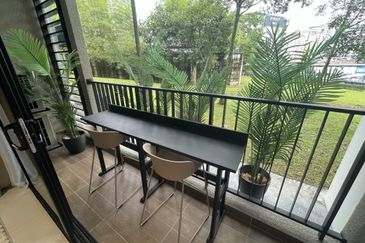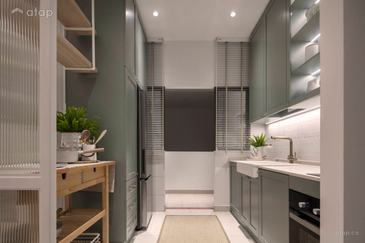
KUALA LUMPUR (Dec 21): There is no foreseeable short-term impact on the construction sector from the depreciation of the ringgit as most construction materials such as cement and steel are manufactured in Malaysia, the national builders group said.
Master Builders Association Malaysia (MBAM) president Matthew Tee (pictured, bottom) however, said that the situation could change if the ringgit continued its downward slide against the US dollar.
The ringgit is currently trading at around RM4.30 to the dollar.
He said unskilled foreign workers in the construction sector were already asking for higher wages, from RM40 to RM50 per day.
Currently, foreign skilled workers already earn fairly high wages, of between RM80 and RM100 per day, but if the ringgit devalues further, they would also demand higher pay.
According to Tee, 70% of the mechanical and electrical components in buildings is imported, such as copper for wiring and cabling and lift products.
In the lift business sector, most suppliers were caught by surprise by the ringgit's free fall, and were unable to increase prices as they had inked contracts with developers and contractors earlier when the ringgit was much stronger.
In the lift business sector, most suppliers were caught by surprise by the ringgit's free fall, and were unable to increase prices as they had inked contracts with developers and contractors earlier when the ringgit was much stronger.

"So if the slide continues, it will definitely have an impact in the longer term.
"For now, contractors and developers can use profit margins to mitigate any currency devaluation.
"But if this continues, businesses will start factoring in the cost increase. For example, the lift suppliers will start to factor in potential price fluctuations in order to make reasonable profits.
"These costs will then be passed on to contractors, who will pass it on to developers, who will pass it on to the end purchaser," he added.
Tee, however, said the construction sector was used to volatile conditions, and had gone through various stages of cost increases and decreases.
"Today it’s the forex, tomorrow it could be cement prices going up.
"For now steel prices have stabilised, but they could increase later on, or transport costs could go up if petrol prices are increased, so we are used to the volatility," he said, adding that the sector was able to overcome such changes in the past.
Tee said while the implementation of the goods and services tax (GST) caused serious cash flow issues for contractors, he was confident they would be able to overcome it eventually.
"The issue now is when we put up a tax invoice, we have to pay the GST upfront, but my client may not pay me fast enough or in full, so there is a cash flow mismatch.
"And on top of that, the Inland Revenue Board is slow in paying us back the GST refund; they say it will be paid in 14 days but they have never met the deadline.
"So it just adds to our cash flow burden, but clients not paying on time has always been a prevalent problem in the industry.
"I must also stress that MBAM supports the implementation of the GST," Tee said.
Smaller contractors affected
While there have been no reports so far of any contractor having to close shop due to declining business, Tee said there was a slowdown in the property sector, including the secondary market which has impacted smaller contractors, for example, those involved in the home renovation business.
But he said this had nothing to do with the depreciating ringgit or the GST, and instead was due to the difficulty purchasers faced in trying to secure housing loans.
According to Tee, based on feedback from the property development industry, the loan rejection rate by the banks is 60%.
He said a meeting with bankers had revealed that banks were keen to lend to interested house buyers, but were restricted by the limitations imposed by Bank Negara Malaysia, which is concerned about increasing household debt.
"So what we have is the secondary market slowing down, because a house buyer who wants to purchase a third property is only eligible to take a 70% loan, so that can be quite tough.
"When secondary sales slow down, contractors who do renovations would have fewer jobs," Tee added.
He said similarly, developers were now holding back on launches not because there was no demand, but because interested housebuyers had difficulty securing loans.
"Here is an example: I asked a developer recently how is business, he said 'Good, but I have to sell my property three times'.
"What he meant was that he would have unsuccessfully sold a unit to two buyers, only to find out that they could not get loans, which means that he had to look for a third buyer for that same unit," Tee said.
But Tee said the outlook for the construction sector in 2016 remained positive, thanks to government jobs including the Light Rail Transit 3, the Mass Rapid Transit project and the slew of highway projects including the Pan Borneo Highway and the Damansara-Shah Alam Elevated Expressway (DASH).
In addition, there was also the Tun Razak Exchange project, commercial skyscraper development Warisan Merdeka and the affordable housing project under PR1MA, said Tee, adding that the government would be under pressure to build these homes before the next general election.
He said as a result of this, there were fewer Malaysian contractors venturing into projects abroad.
"We are busy back home," he said. -- The Malaysian Insider
TOP PICKS BY EDGEPROP

Henna Residence @ The Quartz
Wangsa Maju, Kuala Lumpur

M Adora @ Wangsa Melawati
Wangsa Maju, Kuala Lumpur

M Adora @ Wangsa Melawati
Wangsa Maju, Kuala Lumpur

The Ridge @ KL East (Residensi Rabung KL Timur)
Setapak, Kuala Lumpur

Sunway Avila Residences
Wangsa Maju, Kuala Lumpur

LSH33 ( Laman Seri Harmoni )
Sentul, Kuala Lumpur

M Adora @ Wangsa Melawati
Wangsa Maju, Kuala Lumpur

M Adora @ Wangsa Melawati
Wangsa Maju, Kuala Lumpur

Sunway Rydgeway Puncak Melawati
Taman Melawati, Selangor

Kenwingston Platz Residence
Setapak, Kuala Lumpur

Henna Residence @ The Quartz
Wangsa Maju, Kuala Lumpur

M Adora @ Wangsa Melawati
Wangsa Maju, Kuala Lumpur

M Adora @ Wangsa Melawati
Wangsa Maju, Kuala Lumpur

The Ridge @ KL East (Residensi Rabung KL Timur)
Setapak, Kuala Lumpur

Sunway Avila Residences
Wangsa Maju, Kuala Lumpur

LSH33 ( Laman Seri Harmoni )
Sentul, Kuala Lumpur

M Adora @ Wangsa Melawati
Wangsa Maju, Kuala Lumpur

M Adora @ Wangsa Melawati
Wangsa Maju, Kuala Lumpur

Sunway Rydgeway Puncak Melawati
Taman Melawati, Selangor

Kenwingston Platz Residence
Setapak, Kuala Lumpur















